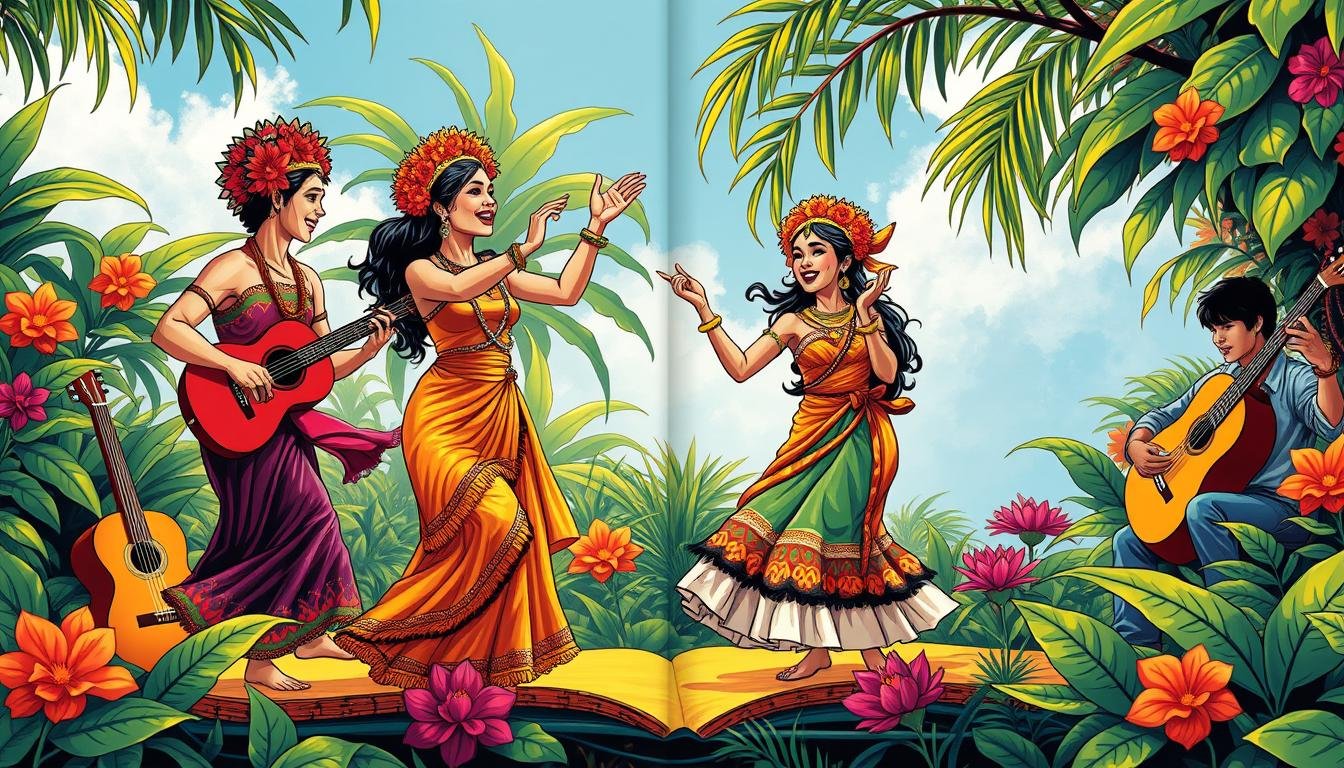How do song and dance show the unique culture and music of the Philippines? The country’s lively culture shines through its music and dance traditions. These traditions unite people and build a strong sense of community. Events like the Black Nazarene procession and traditional dances like itik-itik highlight the richness of Filipino culture.
Key Takeaways
- Filipino culture is known for its love of song and dance, which plays a significant role in expressing Filipino joy and music.
- The country’s traditional folk dances, such as itik-itik, are an important part of its cultural heritage and music.
- Contemporary dance trends, such as those showcased in the “Joy & Daloy” twin bill show, are also gaining popularity in the Philippines and contributing to its culture.
- The interconnections between climate justice, environmentalism, and performance art are highlighted in productions like ItikLandia, which is a part of Filipino culture and music.
- Filipino culture and music are shaped by its history, with influences from indigenous traditions and Spanish colonization, and are reflected in its music.
- The country’s cultural festivals, such as the Lookingfor Juan Outdoor Banner Show, celebrate its unique culture and music.
- Community unity and music are emphasized through cultural traits like “bayanihan” and “kapit-bisig”, which are essential to Filipino culture.
The Cultural Significance of Song in the Philippines
Song is a big part of Filipino culture. It brings people together and lets them express themselves. The Philippines has over 100 different ethnic groups, making its music very diverse. Traditional Filipino tunes mix sounds from Hispanic, American, Chinese, Indian, and Islamic cultures.
Research shows that traditional music is not taught much in schools. This makes people think folk songs are only for kids. It’s important to teach these songs to the next generation.
Historical Roots of Filipino Music
Traditional Filipino music has a deep history. It comes from indigenous traditions, Spanish rule, and American influence. The Balitao, found in Tagalog and Visayan areas, has a unique rhythm and time signature.
Influence of Indigenous Traditions
Indigenous music in the Philippines is passed down through stories and songs. Everyone in the community joins in when music is played. Singing is important everywhere, with songs that go beyond what most singers can do.
The Role of Spanish Colonization
Spanish rule changed Filipino music a lot. It brought in Western instruments and styles. Today, folk music in Christian areas mixes Western and traditional sounds, like Habanera and Polka.
Popular Genres of Filipino Music
Filipino music is a vibrant expression of the country’s culture and heritage. It has a rich history and diverse influences. This has led to the emergence of various genres, each showing the unique sound and style of Filipino music.
The Philippines’ location and history have shaped its music. With over 7,100 islands and a diverse population, the country’s music reflects its cultural diversity. From traditional folk to contemporary OPM, Filipino music has evolved, blending different influences and styles.
Traditional Folk Music
Traditional folk music in the Philippines uses indigenous instruments like the gangsa and kulintang. These instruments are key to Filipino cultural heritage. The kulintang ensemble, in particular, is a significant part of the country’s traditional music.
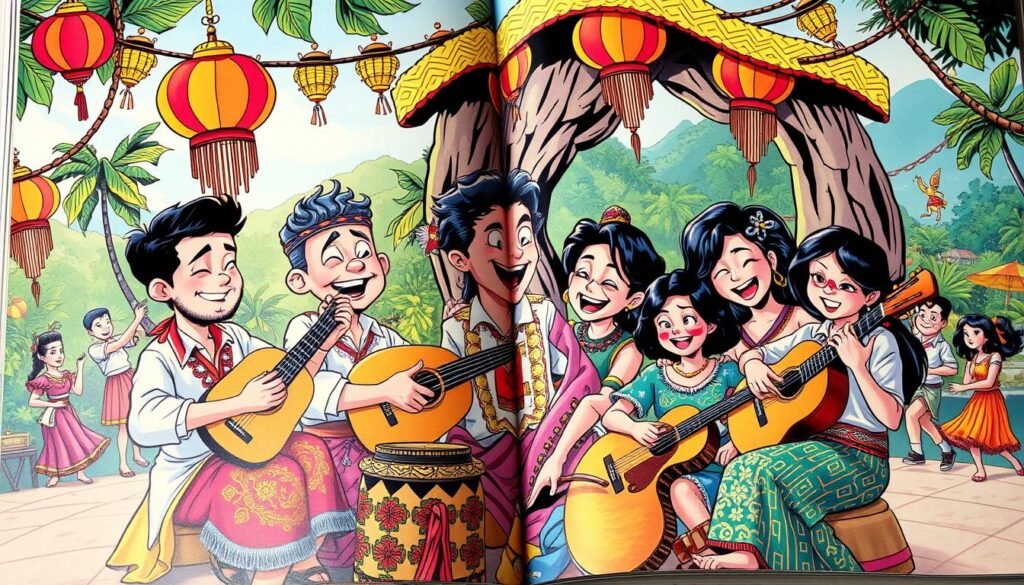
Contemporary OPM (Original Pilipino Music)
Contemporary OPM has become popular in recent years. Artists like Benj Pangilinan are making waves in the music scene. His hit single, “Dance Like You,” shows the evolution of Filipino music.
OPM covers various genres, including folk, rock, and pop. It offers a unique expression of Filipino music and culture.
| Genre | Description |
|---|---|
| Traditional Folk Music | Characterized by the use of indigenous instruments, such as the gangsa and kulintang. |
| Contemporary OPM | Encompasses various genres, including folk, rock, and pop, showing a unique expression of Filipino music and culture. |
The Art of Dance in Filipino Culture
Dance is a big part of Filipino culture. The Philippines has many traditional dances that show off its rich heritage. These dances are often seen during celebrations and festivals.
Traditional dances in the Philippines reflect the country’s history and values. For example, the Tinikling dance requires tapping bamboo poles on the ground, showing off rhythm and coordination. The Pandanggo dance, where dancers balance candles on their heads, highlights grace and poise.
Modern dance trends are also popular in the Philippines. Filipino dancers mix traditional styles with modern ones, like hip-hop and ballet. This blend of old and new dance styles promotes Filipino culture worldwide.
Dance in Filipino culture is full of life and tradition. It brings people together, celebrating their heritage through dance. This way, Filipinos show their pride and unity through dance.
How Music and Dance Unite Communities
Music and dance are powerful tools for uniting people. They help create a sense of community and social bond. Through celebration and artistic expression, people from different backgrounds can come together. They share the joy of music and dance.
This unity is seen in community events and festivals. These events promote a sense of belonging and togetherness. Music and dance help people feel connected.
Music and dance have a big impact on community building. Research shows they improve social skills and academic performance. For example, students in music programs have better attendance and graduation rates.
Music and dance also help people understand each other better. They evoke empathetic responses, bridging gaps between different groups. This is through shared emotional journeys.
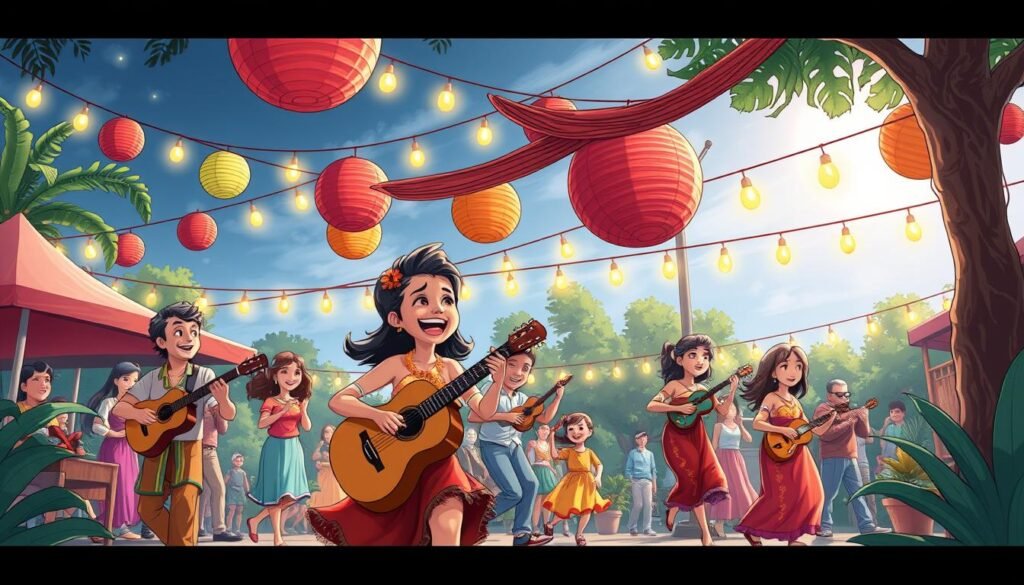
- Community events and festivals, which promote social interaction and a sense of belonging
- Collaborative artistic expressions, such as group dance performances or music ensembles
- Music therapy programs, which can help individuals with social, emotional, or cognitive challenges
Music and dance are key in uniting communities. They foster social cohesion and a sense of belonging. By celebrating music and dance, we can bring people together. This helps create a more harmonious and inclusive society.
The Role of Music in Filipino Celebrations
Music is key in Filipino celebrations, bringing people together. It creates a sense of community. In the Philippines, music is a big part of weddings, family gatherings, national holidays, and local fiestas. The music played aims to unite and bring joy.
At weddings and family gatherings, traditional Filipino music like harana and kundiman songs are played. These songs have unique rhythms and come from courtship rituals. 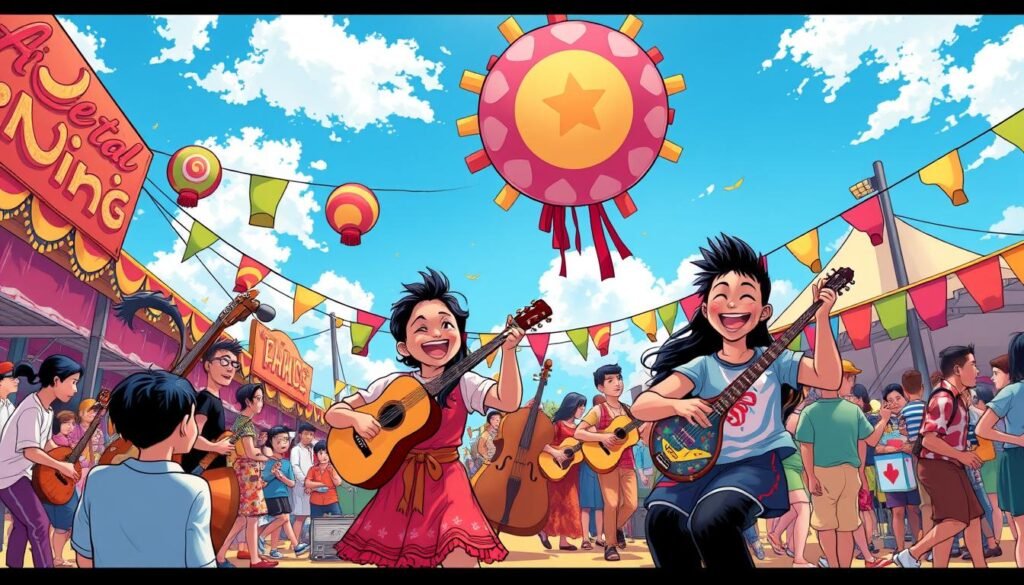
Modern Filipino music also has a big role in celebrations. The Manila Sound genre, which started in the mid-1970s, has greatly influenced modern music in the Philippines. Celebrations often mix traditional and modern music, creating a unique Filipino sound.
| Type of Celebration | Type of Music |
|---|---|
| Weddings and Family Gatherings | Traditional Filipino music (harana and kundiman songs) |
| National Holidays | Modern Filipino music (Manila Sound genre) |
| Local Fiestas | Mix of traditional and modern Filipino music |
In conclusion, music is essential in Filipino celebrations, fostering unity and joy. The blend of traditional and modern Filipino music makes each celebration unique and memorable.
The Influence of Technology on Filipino Music
The music scene in the Philippines has changed a lot with technology. Now, digital platforms make music easy to find and listen to. This change has helped local artists reach more people and get known worldwide.
Streaming services have changed the game for Filipino artists. They can now connect with fans globally without needing big record labels. This means they keep more of their earnings and can make music that fans want to hear.
Some key benefits of technology in Filipino music are:
- Music is now easier to find and listen to.
- Local artists have more power.
- They can work with artists from other countries.
- They can make music based on what fans like.
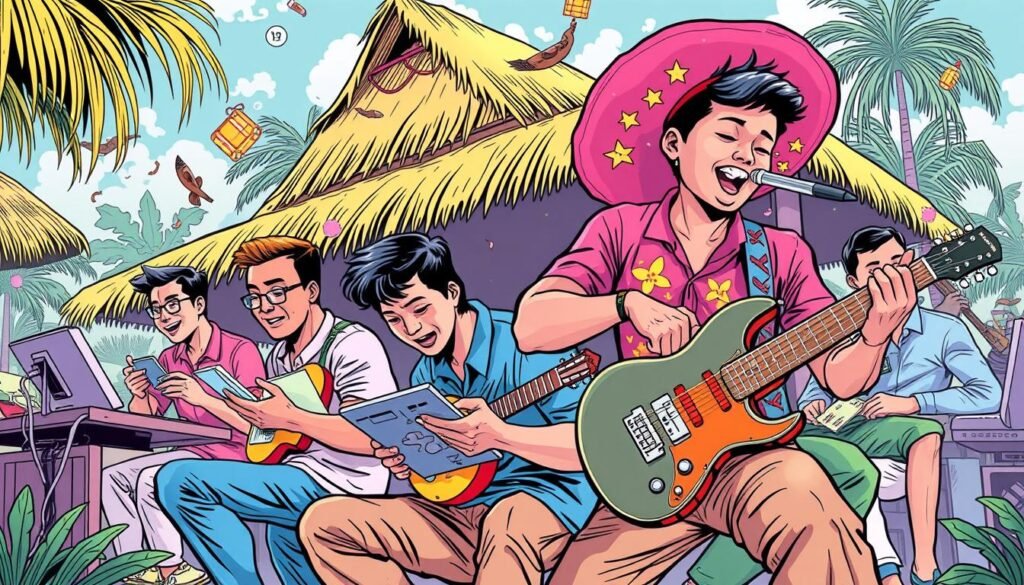
Technology has greatly influenced Filipino music. It will be exciting to see how it keeps changing the industry. With streaming and social media, Filipino artists can share their music and connect with fans everywhere.
| Artist | Genre | International Recognition |
|---|---|---|
| SB19 | Pop | Yes |
| BINI | Pop | Yes |
| Moira Dela Torre | Pop | Yes |
The Importance of Music Education
Music education is key in shaping the next generation of Filipino musicians. It’s included in school curricula, community programs, and workshops. This helps students develop important skills that go beyond school.
Music education boosts memorization, creativity, and imagination. It’s a vital part of a well-rounded education.
Some benefits of music education include:
- Improved memory capabilities
- Enhanced language skills
- Developed teamwork and social skills
- Boosted self-confidence and self-esteem
- Increased overall student engagement and enjoyment in school
Studies show music education’s big impact on kids’ minds and feelings. For instance, a University of Kansas study found kids with music education did better in English and math. Music also improves hand-eye coordination, teaches perseverance, and boosts confidence.
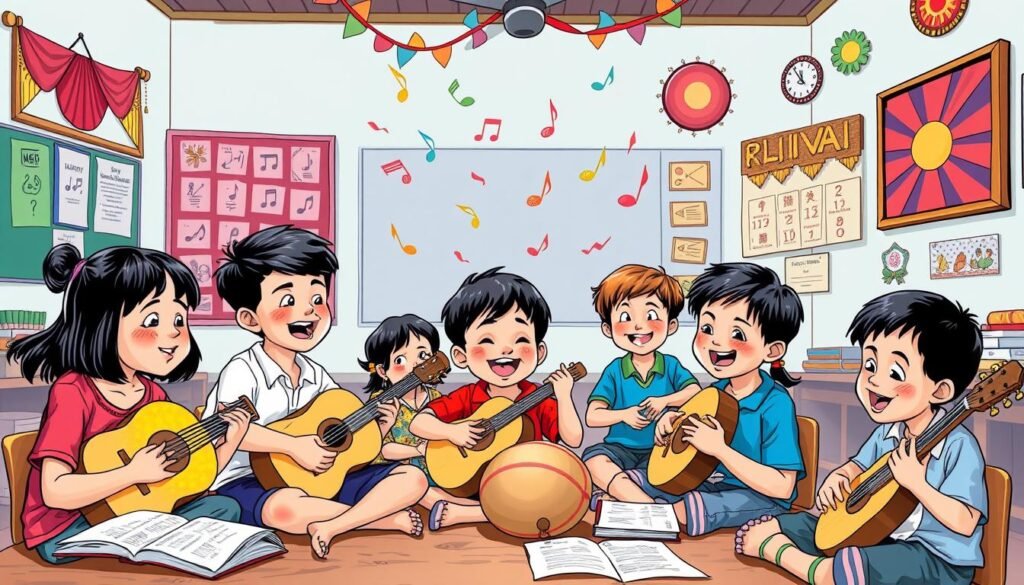
By adding music education to their curriculum, schools offer a unique way for students to learn and express themselves. Benj Pangilinan’s song “Dance Like You” shows music’s power to unite people. Investing in music education empowers the next generation of Filipino musicians, giving them the skills and confidence to succeed.
| Benefits of Music Education | Description |
|---|---|
| Improved Memory | Music education enhances memorization skills, allowing students to recall information more effectively. |
| Enhanced Language Skills | Music education exposes students to a larger vocabulary, improving their language skills and communication abilities. |
| Developed Teamwork and Social Skills | Music education fosters teamwork, social skills, and collaboration, essential for success in all areas of life. |
The Global Reach of Filipino Music
Filipino music has made a big splash worldwide, with many artists getting noticed globally. The Philippine music industry has grown a lot. This is thanks to Original Pilipino Music (OPM) and Pinoy pop (P-pop) music.
More and more international collaborations are happening. Filipino artists like Ben&Ben and Sarah Geronimo have sold out shows in the Philippines and abroad. This shows how much Filipino music is loved worldwide.
Recent stats show that over 70% of Filipino artists use Tagalog lyrics. This makes their music hit with local fans. It shows how culture shapes Filipino music.
Some key stats about Filipino music’s global reach include:
- Pinoy music streams have quadrupled globally over the past five years.
- The top markets for Pinoy music outside the Philippines include the U.S., Canada, Indonesia, Poland, and Australia.
- Global daily streams of the playlist KALYE have increased by 600% in the last five years.
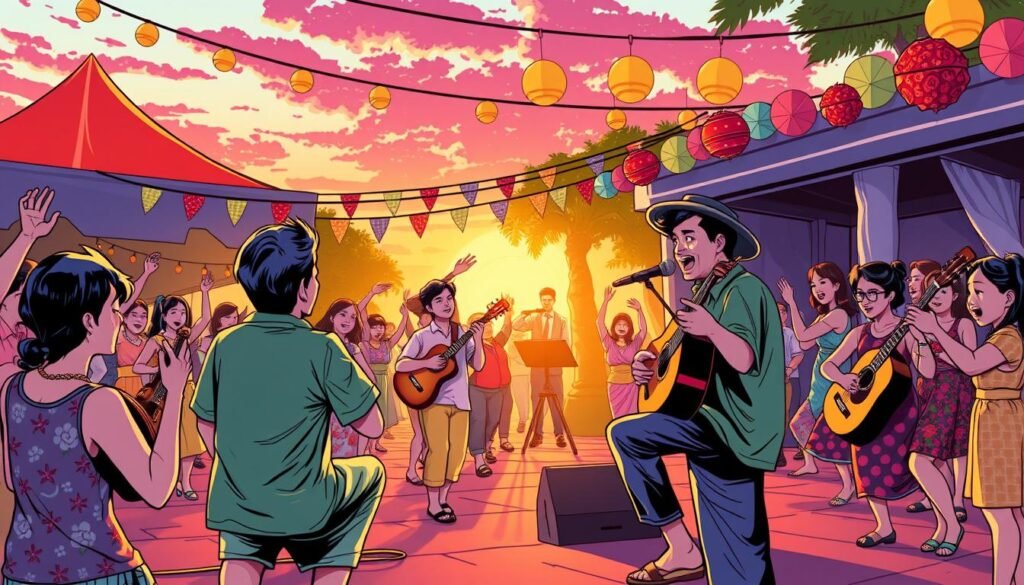
The rise of Filipino music globally is thanks to music streaming. Over 50% of Filipinos use Spotify to listen to P-pop. As the Philippine music industry grows, we’ll see more Filipino artists shine internationally.
Preservation of Traditional Music
Traditional music is key to any culture. It’s vital for keeping cultural heritage alive. In the Philippines, there’s a push to save traditional music. This includes making archives and databases.
The folk song conservation strategies help keep Filipino music alive.
Universities and groups play a big role in saving traditional music. They support research, documentation, and education. This helps keep traditional music going. Also, modern music often draws from traditional sources.
But, there are hurdles like lack of support and modern tech’s influence. Migration and not enough support for traditional music are big problems worldwide. To fight this, we must promote and preserve traditional music, like the Voices of the Americas Heritage Institute does.
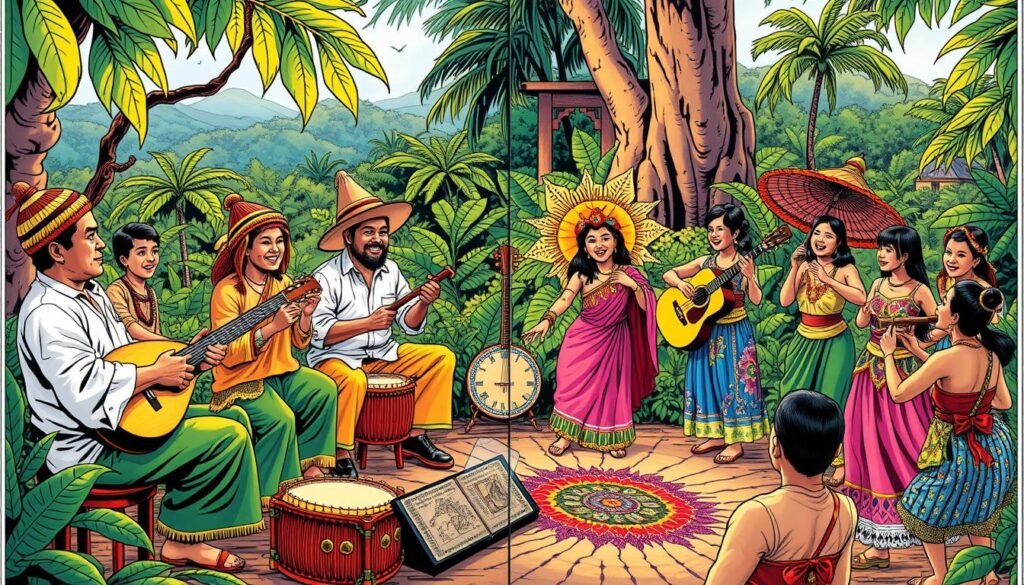
Keeping traditional music alive helps keep cultural bonds strong. As the article unpacking the colonial baggage says, old melodies bring people together. They help us understand each other better, crossing cultural lines.
Iconic Filipino Artists and Their Contributions
Philippine music and culture are rich and diverse. Many iconic artists have made big contributions. For example, the band Eraserheads released seven studio albums and broke up in 2002. They reunited in 2008, leaving a lasting mark on Filipino music.
Other legendary figures include Apo Hiking Society and Parokya ni Edgar. They are known for hits like “Batang Bata Ka Pa” and are called “The National Band of the Philippines.” These artists have greatly influenced the country’s culture and music industry. For more information, visit this link.
Contemporary stars like Rivermaya and Bamboo are also worth watching. Rivermaya is known for their alternative rock and pop rock sound. Bamboo released their debut album “As The Music Plays” in 2004, getting great reviews. Regional artists add unique perspectives and styles to Filipino music.
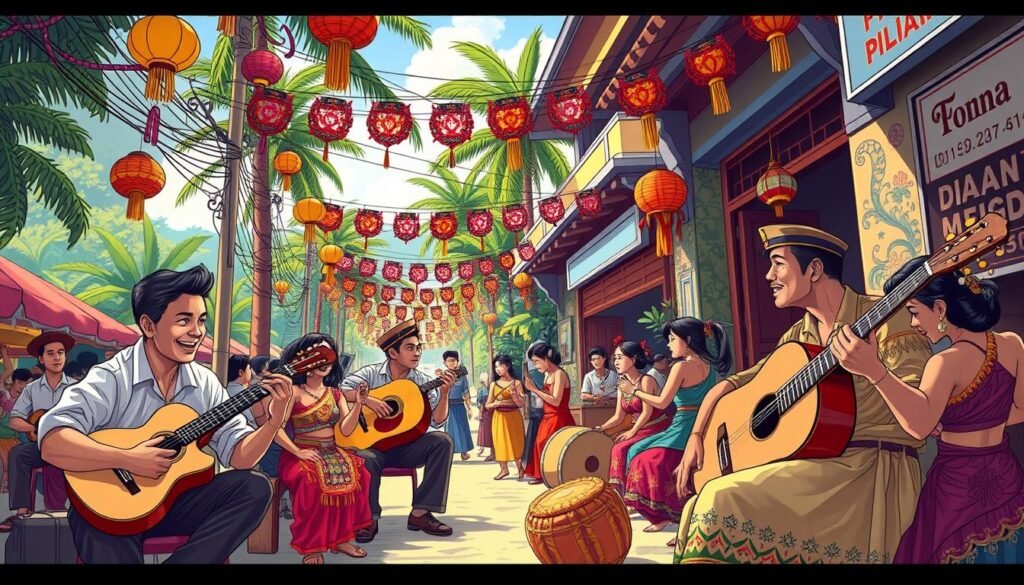
These iconic Filipino artists have greatly contributed to the country’s music scene and culture. Their influence is seen in festivals and everyday conversations. It’s important to recognize and appreciate their contributions as Philippine music and culture continue to grow.
Songwriting as a Form of Expression
Songwriting is a powerful way to express thoughts, feelings, and experiences through music. It lets people be creative and share their stories. A study on self-expression through songwriting found it can improve mental health.
Through songwriting, people share their personal stories. These stories are shaped by their experiences and culture. It can be therapeutic, helping people deal with challenges. Research shows it can even lower stress levels by up to 25%.
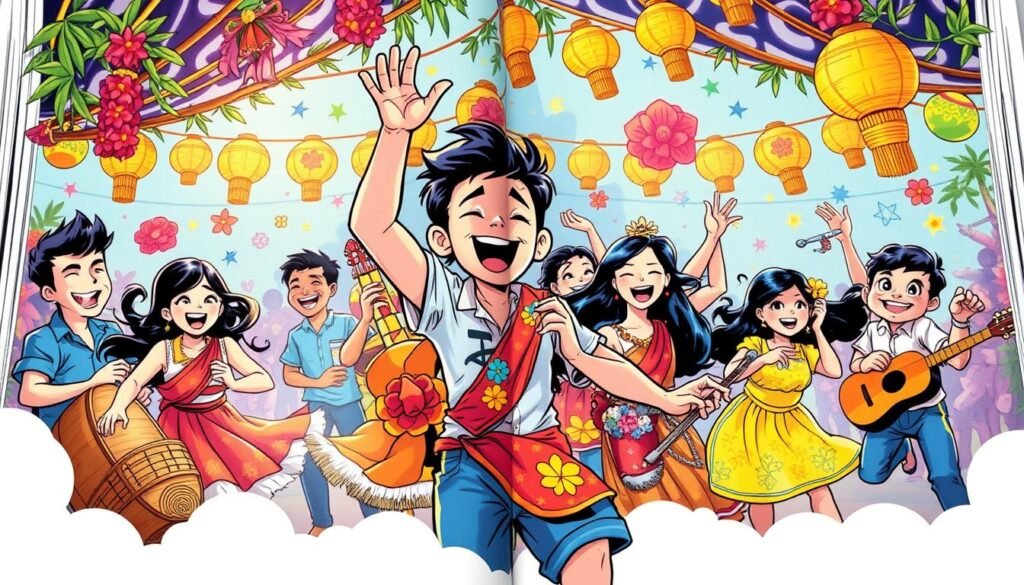
- Motivated participation and enhanced confidence
- Stimulated engagement in creative, cognitive, language, and learning processes
- Development of new coping skills and improved insight into emotions
Songwriting can also bring people together. It allows them to share ideas and create something meaningful. As seen in Simón Ola’s story, music can shape cultural identity and drive social change.
The Role of Music in Filipino Identity
Music is a big part of Filipino identity, showing the country’s rich culture. The history of Filipino music shows how the country has changed while keeping its unique culture.
Music in the Philippines shows national pride, everyday life, and language. Original Pilipino Music (OPM) is a great example. It mixes local and Western styles. OPM has become a big part of Filipino culture, with many types like ballads and rock.
Some key things about OPM include:
- Powerful vocal style, characterized by emotional intensity
- Indigenous Filipino elements, fused with Western musical influences
- Wide acceptance, mainly among the lower classes
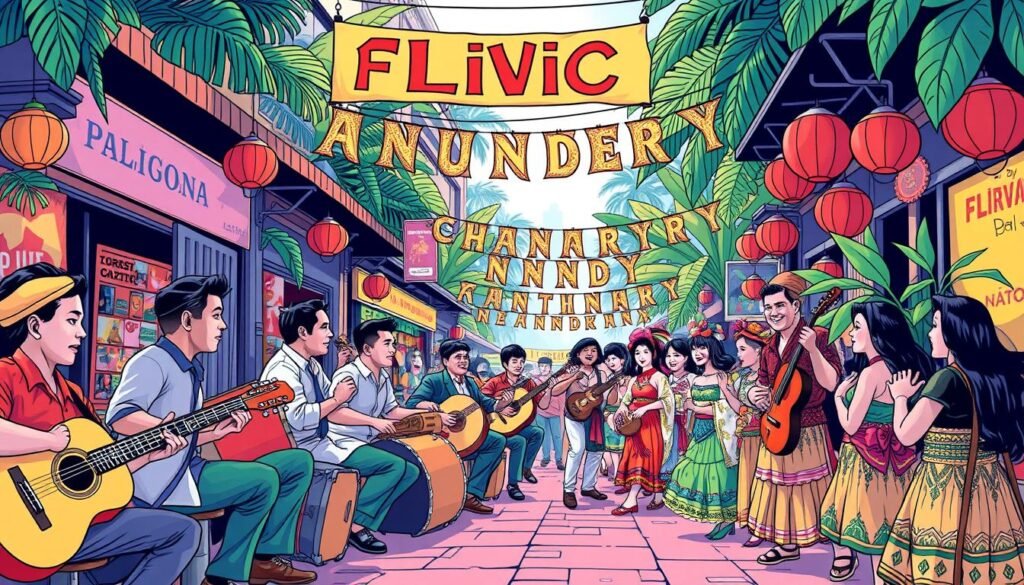
Reflections of National Pride
Music is a big part of Filipino culture, showing national pride and identity. Using Filipino languages in OPM songs helps keep the culture alive.
Music as a Reflection of Everyday Life
Music in the Philippines shows everyday life, with songs about love and social issues. It’s a powerful way to share feelings and connect with others.
The Influence of Language in Song
Language is very important in Filipino music, with many songs in Filipino languages. It helps keep the culture alive and connects listeners who share a common language and culture.
| Music Genre | Description |
|---|---|
| OPM | Original Pilipino Music, a unique blend of indigenous aesthetics and Western styles |
| Ballads | Sentimental songs, often dealing with themes such as love and relationships |
| Novelty Songs | Humorous songs, often dealing with themes such as everyday life and social issues |
The Healing Power of Song and Dance
Music is a powerful tool for healing and expressing ourselves. Studies show it can lower anxiety, depression, and stress. It’s also used in dentist’s offices and operating rooms to help with pain.
Music lets us share our feelings and stories in a unique way. It helps us connect with others deeply. Music has always been a key part of personal growth and healing.
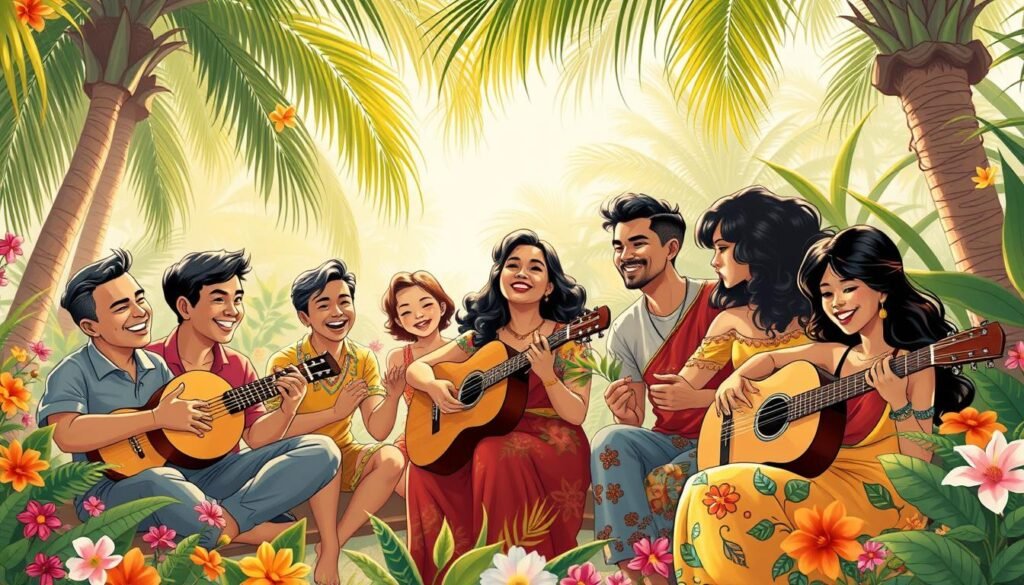
- Reducing stress and anxiety
- Improving mood and cognitive function
- Enhancing creativity and self-expression
- Fostering community and social connection
The healing power of song and dance is amazing. It’s seen and felt by people everywhere. By using music and dance, we can unlock our creativity, bond with others, and enjoy many benefits.
Future of Philippine Music and Dance
The Philippines’ music and dance traditions are captivating people everywhere. The future looks bright, with a mix of old and new. Young artists are leading the way, blending tradition with modern styles.
P-pop, or Philippine pop music, is changing the scene. Groups like SB19, BGYO, and BINI are famous worldwide. They mix traditional sounds with today’s music and dance.
Dance is also evolving. Folk dances like Tinikling and Banga are getting a new life. Young people are making these dances their own, keeping traditions alive.
The future of Philippine music and dance is exciting. It will mix old traditions with new ideas. Thanks to passionate artists and community support, the Philippines’ culture will keep inspiring people everywhere.
FAQ
What is the cultural significance of song and dance in the Philippines?
In the Philippines, song and dance are more than just entertainment. They express joy, celebrate life, and show who we are. These traditions have grown, blending old customs with new influences.
What are the popular genres of Filipino music?
Filipino music is diverse, with folk, OPM, and Western styles. These genres have mixed over time, creating a unique sound. This blend makes Philippine music special.
How do music and dance unite communities in the Philippines?
Music and dance bring people together in the Philippines. They are key at festivals and community events. These activities build unity and social bonds.
What role does music play in Filipino celebrations?
Music is vital at celebrations in the Philippines. It’s heard at weddings, family gatherings, and holidays. The music played shows the heart of Filipino culture.
How has technology influenced Filipino music?
Technology has changed Filipino music a lot. Digital platforms, YouTube, and streaming services have made music more accessible. This has changed how music is made, shared, and enjoyed.
What is the importance of music education in the Philippines?
Music education is key for the next generation of Filipino musicians. Schools, community programs, and youth training are vital. They help keep and grow Filipino music.
How has Filipino music reached a global audience?
Filipino music is known worldwide, thanks to artists, cultural exchanges, and OFWs. This global reach promotes the Philippines’ rich culture.
What efforts are being made to preserve traditional Filipino music and dance?
Efforts to save traditional music and dance are ongoing. Universities, organizations, and community work are involved. These efforts aim to protect Filipino culture.
How do iconic Filipino artists contribute to the music scene?
Famous Filipino artists have greatly influenced music. They inspire and shape the sound of Philippine music. Their impact is huge.
What role does songwriting play in Filipino music and culture?
Songwriting is a powerful way to express in Filipino music. It tells personal stories, reflects society, and encourages teamwork. Songwriting is essential to Filipino music.
How does music influence Filipino identity and culture?
Music deeply connects with Filipino identity. It shows national pride, life experiences, and language influence. Music plays a big role in shaping Filipino culture.
What is the healing power of song and dance in the Philippines?
Music and dance in the Philippines have healing powers. They offer therapy, emotional expression, and community support. These cultural elements are vital for well-being.
What are the future trends and predictions for Philippine music and dance?
The future of Philippine music and dance looks bright. New trends, young artists, and predictions for the next decade are exciting. These developments will shape Filipino music and culture.
Source Links
- ‘Joy & Daloy’ at the CCP plots new paths for Filipino contemporary dance – https://thepost.ph/arts-culture/joy-daloy-at-the-ccp-plots-new-paths-for-filipino-contemporary-dance/
- ONLY IN THE PHILIPPINES – Google Arts & Culture – https://artsandculture.google.com/story/only-in-the-philippines-center-for-art-new-ventures-sustainable-development-canvas/zgXRkeopr5qoJQ?hl=en
- UPHSI students, Panay Bukidnon showcase indigenous Filipino ingenuity – https://www.upv.edu.ph/index.php/news/uphsi-students-and-panay-bukidnon-showcase-indigenous-filipino-ingenuity-in-concert
- Why Filipinos Should Read: ‘The Gift of Song’ Collection by Tahanan Books – https://bookbed.org/2024/09/27/why-filipinos-should-read-the-gift-of-song-collection-by-tahanan-books/
- Philippine folk music – https://en.wikipedia.org/wiki/Philippine_folk_music
- Philippine Music, A Historical Overview – National Commission for Culture and the Arts – https://ncca.gov.ph/about-ncca-3/subcommissions/subcommission-on-the-arts-sca/music/philippine-music-a-historical-overview/
- Music – https://kasaysayanngpilipinas.wordpress.com/music/
- Dance in the Philippines – https://en.wikipedia.org/wiki/Dance_in_the_Philippines
- MUSIC AND ARTS OF THE PHILIPPINES – https://musicnarts.wordpress.com/music-and-arts-of-the-philippines/
- Filipino Art Songs: The Evolution of the Kundiman Genre and its Role in Filipino Identity in the Midst of Colonization — Chrystle Music Studio – https://www.chrystlemusic.com/updates/2019/7/24/filipino-art-songs-senior-lecture-recital
- Impact of Music on Society – Sociological Effects – https://www.savethemusic.org/blog/how-does-music-affect-society/
- EssayGenius AI Essay Writer – https://essaygenius.ai/essay/the-power-of-music-to-unite-people-1
- Music of the Philippines – https://en.wikipedia.org/wiki/Music_of_the_Philippines
- Filipino Dance & Music Repertoire – Samahan Filipino American Performing Arts & Education Center – https://samahanarts.org/filipino-dance-music-repertoire/
- How Streaming is Changing the Philippine Music Industry – https://www.camella.com.ph/how-streaming-is-changing-the-philippine-music-industry/
- "Uso pa ba ang OPM?”: A Semantic Analysis of Original Pilipino Music (OPM) Songs Preferred by Filipino Youth – https://animorepository.dlsu.edu.ph/cgi/viewcontent.cgi?article=1789&context=conf_shsrescon
- PDF – https://files.eric.ed.gov/fulltext/EJ1310659.pdf
- The Importance of Music in School: Why Music Education Matters — Stage Music Center In Acton and Winchester MA – https://stagemusiccenter.com/music-school-blog-winchester-acton-ma/2022/8/7/the-importance-of-music-in-school-why-music-education-matters
- The Importance of Music in Education – https://www.nordangliaeducation.com/news/2020/07/06/the-importance-of-music-in-education
- The Importance of Music Education in Schools – Graduate Programs for Educators – https://www.graduateprogram.org/2020/08/the-importance-of-music-education-in-schools/
- PDF – http://ijdri.com/me/wp-content/uploads/2022/06/6.pdf
- Ppop Goes Global: The International Appeal of Filipino Pop Music – FasterCapital – https://fastercapital.com/content/Ppop-Goes-Global–The-International-Appeal-of-Filipino-Pop-Music.html
- Celebrating 10 Years of Spotify in the Philippines — Spotify – https://newsroom.spotify.com/2024-11-01/philippines-10-year-anniversary-ben-and-ben/
- Rescuing Rhythms: Traditional Music’s Battle Against Extinction – https://medium.com/@chrisrosche/rescuing-rhythms-traditional-musics-battle-against-extinction-6386f6c2cc27
- Preserving Marapu Culture and traditions through song – Voice.Global – https://voice.global/stories/preserving-marapu-culture-and-traditions-through-song/
- 10 Famous Filipino Bands You Need on Your Playlist | Newport World Resorts – https://www.newportworldresorts.com/blog-articles/10-famous-filipino-bands-you-need-your-playlist
- PDF – https://pacitaabad.com/usr/documents/press/download_url/257/tatler-asia-nov-2022-by-franz-sorilla-iv.pdf
- 30 iconic Filipino songs – https://www.philstar.com/entertainment/2016/07/28/1607259/30-iconic-filipino-songs
- Insider’s Guide to Songwriting for Emotional & Social Health – https://www.amusictherapy.com/post/2018/10/07/insiders-guide-to-songwriting-for-emotional-social-health
- Turn feelings and emotions into songwriting – https://www.piedmont.org/living-real-change/turn-feelings-and-emotions-into-songwriting
- In Focus: Constructing a National Identity Through Music – National Commission for Culture and the Arts – https://ncca.gov.ph/about-culture-and-arts/in-focus/constructing-a-national-identity-through-music/
- OPM and its importance to Filipino culture – https://opinion.inquirer.net/166691/opm-and-its-importance-to-filipino-culture
- The Power of Music: To Feel, Heal, and Connect – https://www.mghclaycenter.org/parenting-concerns/families/the-power-of-music-to-feel-heal-and-connect/
- The healing power of music – https://thoughtsfromrabbiron.wordpress.com/2015/10/07/the-healing-power-of-music/
- THE GOLDEN GIFT TO THE FUTURE: TRADITIONAL MUSIC AND DANCES – https://dpsaphilippines.wordpress.com/2016/03/15/the-golden-gift-to-the-future-traditional-music-and-dances/
- The Philippine music industry: its history, present, and future – https://republicasiamedia.com/generation/the-philippine-music-industry-its-history-present-and-future/

